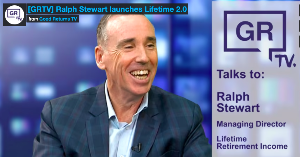Once in a lifetime business - Take two
Ralph Stewart’s Lifetime Income Group has found an effective way to continue to provide income for life without a guarantee or the need for regulatory capital.
Sunday, August 1st 2021, 7:10AM  4 Comments
4 Comments

Stewart established Lifetime Retirement Income to offer investors a variable annuity which was guaranteed for life. Under the scheme investors would be paid a guaranteed income no matter how long they lived.
To meet this promise the company ran a funds management business and a life insurance company. The concept was that when an individual's returns from the investment portion dried up the life company would kick in and continue making the regular payments until that person died.
Lifetime experienced a surge in investors two years ago when interest rates dropped, partly because it was offering a much better income for retirees than traditional term deposits.
With this surge in sales Lifetime's insurance company required more regulatory capital. At one stage sales were so strong it breached solvency standards imposed by the prudential regulator, the Reserve Bank.
After a review and much discussion late last year Lifetime went to the market seeking to raise a minimum of $15 million and up to $25 million.
The capital raise was to meet the company's new regulatory capital requirements and fund growing sales over the coming years.
"The new capital will provide greater protection for existing policyholders and give the business the confidence to grow," Stewart told investors last year.
"As a new company with a new concept we have been working hard to prove the market for guaranteed retirement income products. With demand now clearly proven we need to plan for a bigger business with long-term certainty."
While it ultimately proved unsuccessful, there was no fault found in the business and, while there was price pressure, we have clear affirmation for the value of the business today.
However, the company failed to raise the minimum amount of capital and considered other options including demutualisation.
One of the issues was that key investors were reluctant to invest in a business which had a prudential regulator.
After months of exploring options the company decided launch Lifetime 2.0. This new business would no longer offer a guaranteed retirement income and the insurance company would be wound up.
To achieve this though Stewart and his team would have to convince the majority of investors to switch from the old fund to the new, Next Generation Lifetime fund.
Stewart describes the new fund as an evolution of its original retirement income product, which no longer had an explicit guarantee or the need for regulatory capital.
It pays investors an annual income (paid fortnightly) based on an individual’s age, gender, personal tax rate, expected mortality and investment returns.
Lifetime manage the capital and reset the income rates each year to ensure the capital will last to a least an individual’s expected mortality plus a buffer.
Stewart describes the results of the transfer "excellent". In the end 72% or $95 million of the variable annuity funds under management transferred to the new fund.
Lifetime now has $233 million in funds under management including its superannuation business, Garrison Bridge.
| « [GRTV] Looking after advisers' mental health | [GRTV] Time for a new code for managers » |
Special Offers
Comments from our readers
As portfolio returns 'normalise' (eg: single digit returns versus a 30 year history of double digit returns), the entire financial services industry (aka the value chain) will suffer it's biggest challenge yet: justification.
Every industry participant will need to demonstrate value-for-money, with the overall cost to consumers standing out like the proverbial. That's when things get a bit tricky, as consumers will no longer pay a premium for 'commoditised' / me-too services & products. The rise of technology will also have a role to play here... but then, that's another story.
I'm not sure what the exact cost of a 'balanced' fund enabling monthly distributions is today, but suspect that consumers can purchase these for circa 50bps. If my comments above are half correct, then the price of these capabilities will no doubt head south over the next decade.
I genuinely wish Ralph & the team best of luck with this initiative - as they are true innovators and worthy of success - although I have genuine concerns around price versus value in the coming years...
Another way to look at is we have take the NZ Society Of Actuaries advice of retirement income and automated it.
Not as strong as a guaranteed income - hear you. Valuable none the less I hope.
Pragmatic, short answer is 100% agree, we have the challenge of reducing our costs materially over the next few years to lower investor costs.
Believe me totally on the scale game as fast as we can.
Bernie, thank you please watch this space our next innovation is approaching the end of the product development process and I hope will be in market by the end of the year - it's FAB!
Best to all Ralph
Sign In to add your comment
| Printable version | Email to a friend |


